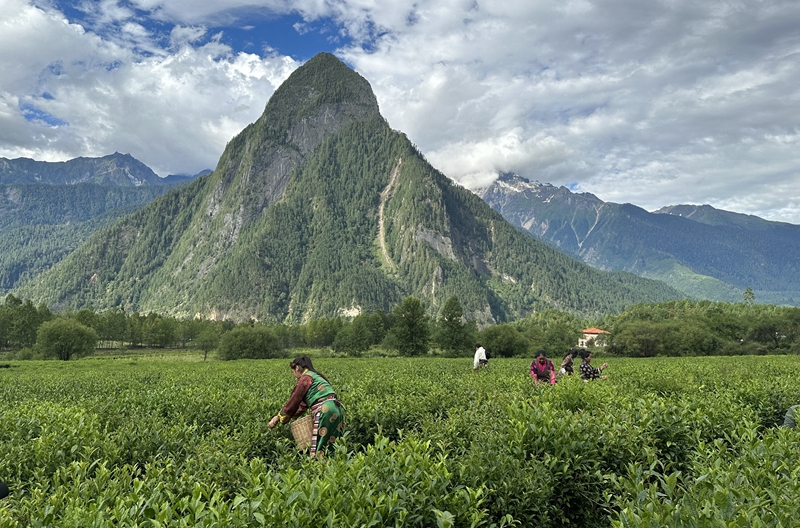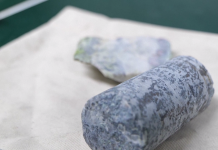
At 51 years old, Li Dong, a guesthouse owner and tea grower in Made Village, Medog County, Nyingchi City, Xizang Autonomous Region, has 869 friends on super app Weixin—over 400 of them are her customers. Every tea-picking season, she posts short videos or hosts livestreams featuring tea picking and processing, and the orders keep flowing in.
“In the first half of this year alone, I earned more than 90,000 yuan ($12,570) from selling tea and running a guesthouse,” Li Dong told Beijing Review. Her income during this period was 7.5 times the national average for rural residents.
In Medog, many residents like Li have achieved prosperity through growing tea and engaging in tourism. Yet 13 years ago, tea growing was still a rarity for the county’s residents. As the last county in China to be connected by paved road, Medog was plagued by a lack of major industries.
In 2011, Medog established its first experimental tea plantation, covering only 6 hectares, with the help of a team from Fujian Province under a paired-up assistance program. In 1994, the Central Government established a program to provide greater support for Xizang. Under the program, some more developed provinces were asked to partner with and help the development of specific cities and counties in Xizang. Since then, Fujian and Guangdong provinces have been teaming up with counties in Nyingchi.
The trial was a success—tea thrived in Medog thanks to its annual average temperature of 16 degrees Celsius, abundant rainfall and mineral-rich soils with ideal acidity. “Although Medog was perfect for growing tea, it had never produced any before, as the lack of large-scale transport [and the lack of skills to process it] meant any freshly picked tea would have spoiled before it reached markets outside the county,” Liu Ao, Deputy Mayor of Medog County, told Xinhua News Agency in May.
The turning point came in October 2013, when the 117-km Medog Highway opened, linking Medog with Bomi County in Nyingchi. Along with the road came tourists in droves and a fledgling tea-growing industry.
The following year, Medog drafted a tea industry development plan, sending officials and villagers to Guangdong’s high-mountain tea plantations to learn about tea-growing skills and bring technical experts back to Medog. In 2015, more and more villagers were encouraged to start growing tea. Three years later, Medog tea was certified as a National Geographical Indication product, boosting its reputation.
In 2019, at the age of 45, Li began learning how to grow tea. “At first, experts from Fujian and Guangdong came to teach us step by step—pruning, weeding and picking,” she told Beijing Review. In addition, the growers were offered free training on online promotion. Now, Li has become a veteran in the business.
Since 2023, Medog has made greater efforts to promote its local brands. In 2025, Medog Tea Co. Ltd., established 10 years earlier, became Xizang’s only tea enterprise to be recognized as a National Leading Agribusiness in Agricultural Industrialization. As of May, the county had built 103 organic tea gardens covering 1,267 hectares in total, making it the largest tea-producing area in Xizang.
“Tea income has played a big role in poverty alleviation. Since 2013, villagers have harvested about 1.2 million kg of fresh tea leaves, generating over 50 million yuan ($7 million) income,” Liu said.
Xizang-grown tea
Although Medog is home to the largest tea-growing area in Xizang, it is not the birthplace of tea in the region. That honor goes to the Yiong Tea Plantation in neighboring Bomi County, Nyingchi.
Tea is a beloved beverage in Xizang, where a Tibetan saying goes, “Better three days without food than one day without tea.” According to data released in 2021 by the region, annual per-capita tea consumption in Xizang was approximately 8 kg, among the highest in China.
However, Xizang did not grow its own tea before the 1960s. Tea, often made from lower-grade tea leaves or fermented dark tea, was pressed into the shapes of bricks and cakes in Sichuan and Yunnan, then carried into Xizang via the ancient Tea Horse Road, a network of trade passages in southwest and northwest China that primarily facilitated the exchange of tea and horses by caravans.
The beginning of Xizang’s tea industry dates back to the 1960s, when the predecessor of Yiong Tea Plantation, the Yiong Military Reclamation Farm, introduced small- and medium-leaf tea bushes from Sichuan, successfully trialing tea cultivation in Xizang for the first time. But progress remained slow: As of 1988, the total tea plantation area in Xizang was only about 142 hectares, far from meeting local demand.
In 2012, China ramped up its efforts to eradicate extreme poverty, and cultivating local industries became one of the major ways to alleviate poverty in the country. Xizang, aiming to make tea growing a pillar industry, stepped up investment and rolled out policies to boost the industry. In 2016, the region established the Xizang Tea Culture Association. In 2019, the regional tax authority exempted tea brick producers from value-added tax, giving the sector a strong push.
Also, technical support from experts from Fujian and Guangdong has further accelerated development. One of the experts is Wu Hualing, a scientist specializing in the breeding of tea varieties used to produce fermented black tea and a researcher at the Guangdong Academy of Agricultural Sciences. From 2022 to 2025, she served as production director at Yiong Tea Plantation as part of Guangdong’s 10th team to help develop Xizang.
Her team introduced techniques such as intercropping soybeans or clover between tea rows, which not only suppress weeds but also enrich the soil through nitrogen fixation, enabling sustainable cultivation. Also, they taught local growers the picking methods that produce the highest quality tea.
“These techniques must be taught step by step. Only when local farmers truly master them can production efficiency and sustainability be improved across growing and processing,” Wu told Beijing Review.
In addition to offering them regular training sessions, the team has also invited locals to visit tea plantations in Sichuan, Fujian and Guangdong. They have trained over 500 tea growers so far.
In addition, the plantation introduced Xizang’s first standardized and automated tea production line, with an investment of 12 million yuan ($1.68 million). “In the past, one worker could manually produce 80 to 100 bricks of tea per day. Thanks to the production line, one worker can now make 500 to 600 per day. The new production line has helped increase efficiency six fold,” Wu told Beijing Review.
With standardized tea gardens, soil improvement and refined management, Yiong Tea Plantation has achieved growth in output and efficiency. Beyond six retail stores in Xizang, its products have entered markets in Shanghai, Guangzhou and other regions, with sales steadily rising.
By 2025, Nyingchi had 3,600 hectares of tea plantations, generating 36.86 million yuan ($5 million) in annual output value—a 14-percent year-on-year increase, helping over 4,300 households—14,600 farmers and herders.
Healthier tea
In Xizang, people traditionally drink tea plain, or with butter and or sugar—all brewed from brick tea. While brick tea is rich in vitamins, its raw materials often include coarse old leaves and stems, which contain fluoride at levels much higher than in tender-leaf teas, typically 500-800 mg/kg. Excessive fluoride intake can cause dental and skeletal fluorosis, a potentially serious condition affecting health and mobility.
In 2020, China’s National Health Commission issued guidelines recommending brick tea with fluoride levels of less than or equal to 300 mg/kg. Xizang’s government followed up with policies by granting subsidies for low-fluoride tea and promoting healthy tea consumption.
Through scientific research partnerships, breakthroughs were made in lowering fluoride levels while maintaining traditional flavor. Companies such as Yiong Tea Plantation and Medog Tea Co. Ltd. have improved processing methods to reduce fluoride content.
These efforts have paid off. According to Xizang’s Department of Commerce, before 2000, brick tea accounted for more than 98 percent of tea consumed in Xizang. Since then, loose-leaf black, green and flower teas have steadily gained popularity, now making up over 15 percent of the regional tea market. Xizang has not only achieved the transformation from tea consumer to producer—its residents are also embracing healthier tea. –The Daily Mail-Beijing Review News exchange item




